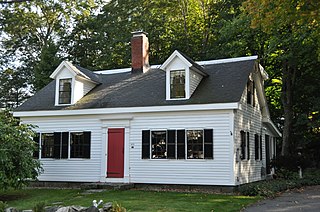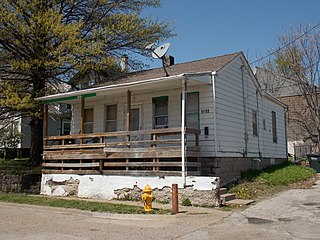
List of the National Register of Historic Places listings in Essex County, New York.

List of the National Register of Historic Places listings in Franklin County, New York
The Confederate Memorial State Historic Site is a state-owned property occupying approximately 135 acres (55 ha) near Higginsville, Missouri. From 1891 to 1950, the site was used as an old soldiers' home for veterans of the Confederate States Army after the American Civil War. The Missouri state government then took over operation of the site after the last veteran died in 1950, using it as a state park. In 1981, a cottage, a chapel, and the Confederate cemetery were listed on the National Register of Historic Places as the Confederate Chapel, Cemetery and Cottage. The chapel was moved from its original position in 1913, but was returned in 1978. It has a tower and a stained glass window. The cottage is a small wooden building, and the cemetery contains 723 graves. Within the cemetery is a monument erected by the United Daughters of the Confederacy which is modeled on the Lion of Lucerne. In addition to the cemetery and historic structures, the grounds also contain trails, picnic sites, and fishing ponds.

The Peter A. Beachy House is a home in the Chicago suburb of Oak Park, Illinois that was entirely remodeled by architect Frank Lloyd Wright in 1906. The house that stands today is almost entirely different from the site's original home, a Gothic cottage. The home is listed as a contributing property to the Frank Lloyd Wright-Prairie School of Architecture Historic District, which was listed on the U.S. National Register of Historic Places.

Wawaset Park is a planned community national historic district located on the western edge of the City of Wilmington, New Castle County, Delaware. The area was formerly the grounds of Schuetzen Park, a horse racing and later auto racing track and fairgrounds. It was purchased in 1917 by the DuPont Company and developed into single-family houses, semi-detached and row houses to meet the housing need for the company's expanding corporate staff. The historic district encompasses 321 contributing buildings and 1 contributing structure.

Radnor-Winston is a small community centered near the intersection of York Road and Winston Ave in the North District of Baltimore. Radnor Winston is a friendly, affordable and diverse neighborhood of about 220 homes tucked behind the campuses of Loyola University and The College of Notre Dame. Located in the Roland Park Public School district, the neighborhood is convenient to both downtown Baltimore and Towson.

Maples Cottage is a historic cottage in Westborough, Massachusetts, USA. Located on the former grounds of the Lyman School for Boys, this Greek Revival cottage was built in 1832 by Rev. William White on the site of a 1725 parsonage. The property was acquired by the state in 1884, and used as part of the reform school, which is now closed. The building has lost most of its exterior Greek Revival styling.

The House at 483 Summer Avenue in Reading, Massachusetts, USA, is a modestly decorated vernacular Federal style cottage. The 1+1⁄2-story wood-frame house was built c. 1830, late for a Federal style building. Its significant Federal features are its five-bay facade, side-gable roof, and the door surround, which has pilasters supporting a tall entablature with a projecting cornice. The house is finished in wooden clapboards, and has two gabled dormers projecting from the front roof.

This is a list of the National Register of Historic Places listings in Henrico County, Virginia.

The Michael Foley Cottage is a historic house at 14 Emerson Street in Stoneham, Massachusetts. It is a remarkably well preserved instance of a worker's cottage, built c. 1855. It was occupied until the 1870s by Michael Foley, a shoemaker who may have worked at the nearby Tidd shoe factory. It is a two-story wood-frame structure, with a front-gable roof, clapboard siding, and granite foundation. Its front facade has three narrow bays on the first floor and two on the second, with the entrance in the rightmost bay. Decorative woodwork is minimal.

The House at 19 Tremont Street is the smallest extant 19th century worker's cottage in Stoneham, Massachusetts. Built c. 1850, it is a stylistically vernacular single-story wood-frame structure, four bays wide, with a side gable roof, clapboard siding, and a brick foundation. Its only significant decorative features is its entry, which has sidelight windows typical of the Greek Revival period. It is the best surviving example of what was once a row of worker cottages that lined Tremont Street.

Forest Hills Historic District is a national historic district located at Indianapolis, Indiana. It encompasses 173 contributing buildings and 7 contributing structures in a planned residential section of Indianapolis. It developed between about 1911 and 1935, and includes representative examples of Tudor Revival and English Cottage style architecture.

The Waverley Historic District is located in Enid, Oklahoma, and has been listed on the National Register of Historic Places (NRHP) since 2006. It consists of four Waverley additions. The William and Luther Braden farm was the first parcel of land to be platted by the Waverley Development Company in May 1902. Subsequent additions were platted in 1905, 1906, and 1907. The District has 275 buildings built between 1895 and 1935. Architectural styles in the district include Queen Anne cottages, Folk Victorian houses, Colonial Revival houses, Craftsman Bungalow and Prairie School Foursquare Houses. There are also a few Tudor Revival, Neoclassical, Italian Renaissance, and Spanish Eclectic homes.

The Cottage at 1514 and 1516 West Second Street is a historic building located in a residential-light industrial area of the West End of Davenport, Iowa, United States. Philippe Oszuscik in his 1979 study of Davenport architecture identified this small cottage as one of the earliest house types in the city. It features a full size front porch that was taken from the Galerie of Mississippi Valley French tradition and a symmetrical, 5-bay main facade that reflects the Georgian and Greek Revival styles. The present porch, however, is not original to the house. The side gable, single-story frame house is built on a stone foundation and has an extension off of the back. The cottage was listed on the National Register of Historic Places in 1983.

The Cottage Home Historic District is a historic district and neighborhood located on the near east side of Indianapolis, Indiana. A small portion of Cottage Home is listed on the National Register of Historic Places while a larger area is listed on the state and local levels. Known for its preponderance of "cottage-style" homes built with strong Victorian influences, Cottage Home has historically been a working class neighborhood. Numerous industrial buildings are also scattered throughout the district, providing a base of economic activity. Today, however, many of these buildings are vacant, providing a special challenge to preservation and urban renewal efforts.

The T. H. Cabot Cottage is a historic summer house off Snow Hill Road in Dublin, New Hampshire. The cottage is one several buildings that was built by geologist Raphael Pumpelly on his summer estate "Pompilia". Built in 1899 after his daughter's marriage to Thomas Handasyd Cabot, it is a good example of Georgian Revival architecture. The house was listed on the National Register of Historic Places in 1983.

The Wildwood Cottage is a historic house on Bancroft Road in Harrisville, New Hampshire. Built in the 1860s, this 1+1⁄2-story Greek Revival cottage is one of two surviving houses associated with a small-scale industrial area known as "Mosquitoville". It was probably the residence of the owners of the sawmill at the site. The Mosquitoville complex, was an economically significant part of the town for nearly 100 years, supplying wooden parts to the mills in the center of Harrisville. This house stylistically resembles some of those built in the village.
The Maysville Historic District is a historic district in Mobile, Alabama, United States. The district covers 451 acres (183 ha) and contains 1121 properties located southwest of downtown and directly south of the Leinkauf Historic District. Platted in 1871 in the midst of a recession in Mobile, the neighborhood did not begin to develop until the late 1890s. Maysville has long been a working class neighborhood; many late 1890s and early 1900s houses were bungalows and cottages, some with modest Victorian influences. Some larger and more decorated houses were built in the northeastern portion of the neighborhood. In the early 20th century and into World War I and World War II, the Port of Mobile and its shipyards became a focus of Mobile's economy, and the population grew in response. The early 20th century saw many craftsman-style bungalows and four square houses built. Minimalist Traditional and some ranch-style houses became popular around and after World War II. Notable contributing buildings in the district are Ladd–Peebles Stadium, built in 1948, and Williamson High School, built in 1965. The district was listed on the National Register of Historic Places in 2013.

Holy Rosary–Danish Church Historic District, also known as Fletcher Place II, is a national historic district located at Indianapolis, Indiana. The district encompasses 183 contributing buildings in a predominantly residential section located in the central business district of Indianapolis. It was developed between about 1875 and 1930, and include representative examples of Italianate, Gothic Revival, Tudor Revival, and Renaissance Revival style architecture. Located in the district is the separately listed Horace Mann Public School No. 13. Other notable buildings include the John Kring House, Trinity Danish Evangelical Lutheran Church (1872), John Wands House (1857), Henry Homburg House, Samuel Keely House, Maria Wuensch Cottage, and Holy Rosary Catholic Church (1911-1925).

The James P. Newton House and Maid Cottage are historic buildings located in Sioux City, Iowa, United States. Newton was a prominent local businessman associated with Haskins Bros. & Co., whose principal product was soap. He was a traveling salesman with the company before he and his brothers bought the company in 1907. He succeeded his brother William as president in 1929. Newton had prominent Sioux City architect William L. Steele design this house, and it is one of his earliest works in the city. The 1½-story frame American Craftsman house and the single-story frame maid's house near the alley feature clapboard siding, porches with square columns, and low pitched hipped roofs with dormers. The bands of color and the wide eaves are elements from the Prairie School style for which Steele would become well known. The two houses were listed together on the National Register of Historic Places in 2000.





















